What to expect in an Icelandic winter – the good, the bad and the stormy
“Memories are made from experiences, not from pictures.”
This month’s post was started while cuddled up under a big blanket, stuck indoors during the first ever Red rated storm in Iceland’s history. However, this post was also completed two days later while chilling out in a cafe under perfectly blue skies and not a whisper of wind. This month I will delve into the Iceland climate, what to wear, how to deal with the bad weather if you’re unlucky and what you can still experience at this time of year despite it. I often quip to people I speak to that “there’s no such thing as a full week of bad weather in Iceland”. Then sadly add… “or good weather”.
 Icelandic climate
“It’s warmer than you think!”
Temperature
Iceland skirts the edges of the Arctic Circle between 64 and 66 degrees. You would be mistaken for thinking that means that Iceland is a barren icy tundra devoid of life, especially in winter. Thankfully this is not the case. In fact, other areas at the same latitude have a much colder climate in winter. While similar places in Canada might experience minus 20C and minus 30C throughout winter it’s rare for Icelanders to experience anything below minus 10C. And far more frequently, get to experience plus 5C or plus 10C. This is partially due to the Gulf stream constantly sending warm water from the gulf of Mexico up and around Iceland year round. Believe it or not, the average temperature in Iceland in January is actually above zero in many parts (0.3C to be exact). New York is colder, on average, than Iceland.
“If you don’t like the weather in Iceland… just wait five minutes.”
Temperate climate
It isn’t all good news though. With the warm air circulating Iceland and interacting with lower pressures a temperate climate is created. This can mean rain, snow, wind, sunshine and clouds. Maybe all on the same day. Many times throughout the winter I’ve had customers shiver as they walk towards the glacier for our hike. Then when on the ice, as the sun peeks out from the clouds they complain about overheating. This might have something to do with the seven layers they are wearing, but it also shows that the temperature can fluctuate quite drastically throughout the day.
Snow and ice
Snowfall and ice are a common sight in an Icelandic winter, but by no means guaranteed. There’s a reason Iceland isn’t known for its skiing. For every frozen snowstorm, there’s a heating event following it with rain to wash a lot of it away. For example, right now (mid December) it’s -8C with snow blanketing everything. Incredibly beautiful. But the forecast is suggesting the temperature is going to rise to +5C by the end of the week with rain accompanying it. If the warmer weather lasts long enough the snow may disappear before Christmas at this rate. Luckily, Iceland without snow is just as picturesque with the deep greens of the Icelandic moss covering many fields, punctuating the bright glacial blues that pour over the mountains in the distance.
Icelandic climate
“It’s warmer than you think!”
Temperature
Iceland skirts the edges of the Arctic Circle between 64 and 66 degrees. You would be mistaken for thinking that means that Iceland is a barren icy tundra devoid of life, especially in winter. Thankfully this is not the case. In fact, other areas at the same latitude have a much colder climate in winter. While similar places in Canada might experience minus 20C and minus 30C throughout winter it’s rare for Icelanders to experience anything below minus 10C. And far more frequently, get to experience plus 5C or plus 10C. This is partially due to the Gulf stream constantly sending warm water from the gulf of Mexico up and around Iceland year round. Believe it or not, the average temperature in Iceland in January is actually above zero in many parts (0.3C to be exact). New York is colder, on average, than Iceland.
“If you don’t like the weather in Iceland… just wait five minutes.”
Temperate climate
It isn’t all good news though. With the warm air circulating Iceland and interacting with lower pressures a temperate climate is created. This can mean rain, snow, wind, sunshine and clouds. Maybe all on the same day. Many times throughout the winter I’ve had customers shiver as they walk towards the glacier for our hike. Then when on the ice, as the sun peeks out from the clouds they complain about overheating. This might have something to do with the seven layers they are wearing, but it also shows that the temperature can fluctuate quite drastically throughout the day.
Snow and ice
Snowfall and ice are a common sight in an Icelandic winter, but by no means guaranteed. There’s a reason Iceland isn’t known for its skiing. For every frozen snowstorm, there’s a heating event following it with rain to wash a lot of it away. For example, right now (mid December) it’s -8C with snow blanketing everything. Incredibly beautiful. But the forecast is suggesting the temperature is going to rise to +5C by the end of the week with rain accompanying it. If the warmer weather lasts long enough the snow may disappear before Christmas at this rate. Luckily, Iceland without snow is just as picturesque with the deep greens of the Icelandic moss covering many fields, punctuating the bright glacial blues that pour over the mountains in the distance.
 The wind
The wind is always the first thing that many people mention when talking about the weather in Iceland. When it’s windy, it’s memorable. The wind chill can make a +10C day feel like -5C. And without wind a -10C day can feel quite pleasant. Iceland is a windy place, sure, but I’m always quick to defend Iceland’s weather. It’s not as windy as often as you may think. Being from Scotland originally, I’m well equipped with the unpleasantness of a stiff wind so I feel like I can say this. The wind is like a pimple. You definitely notice when it’s there but pay little attention when it isn’t. Right now there is no wind. And as further proof I can confirm my adventure company very rarely cancels our glacier hikes due to the wind. Even on a windy day there’s often some respite in sheltered areas.
The darkness
The darkness that is associated with Icelandic winter is very real. No debate about that. As we approach the shortest day of the year we will barely get 4 hours of direct sunlight. This makes fitting in outdoor activities much harder so keep that in mind. It does however also mean you have ample time to hunt for the northern lights. As a general rule, from the 21st of December onwards you gain roughly 5 minutes of extra daylight per day. About half an hour a week. So if you come in October, early November and February or March the chances are you will have plenty of time to explore during the day.
The wind
The wind is always the first thing that many people mention when talking about the weather in Iceland. When it’s windy, it’s memorable. The wind chill can make a +10C day feel like -5C. And without wind a -10C day can feel quite pleasant. Iceland is a windy place, sure, but I’m always quick to defend Iceland’s weather. It’s not as windy as often as you may think. Being from Scotland originally, I’m well equipped with the unpleasantness of a stiff wind so I feel like I can say this. The wind is like a pimple. You definitely notice when it’s there but pay little attention when it isn’t. Right now there is no wind. And as further proof I can confirm my adventure company very rarely cancels our glacier hikes due to the wind. Even on a windy day there’s often some respite in sheltered areas.
The darkness
The darkness that is associated with Icelandic winter is very real. No debate about that. As we approach the shortest day of the year we will barely get 4 hours of direct sunlight. This makes fitting in outdoor activities much harder so keep that in mind. It does however also mean you have ample time to hunt for the northern lights. As a general rule, from the 21st of December onwards you gain roughly 5 minutes of extra daylight per day. About half an hour a week. So if you come in October, early November and February or March the chances are you will have plenty of time to explore during the day.
 So with all that said, what should you do when you travel to Iceland to embrace this new climate and untamed wilderness?
The first ever Red storm in Iceland’s history: The Bomb Cyclone
Let me caveat the above title by stating that the colour gauge is a relatively new warning system for Iceland. This week’s storm was by no means the worst ever. But it certainly was the worst in the past few years. I can’t say I’ve experienced something quite like this since I started calling iceland my home.
It begun just a few days ago without much warning. I gasped to hear that in some parts of the country winds up to 50m/s (110mph) were being felt with 2 metres (7ft) of snow falling in quick succession. Houses were buried in snow and power outages were felt by over 20,000 people across the country. Videos of animals being rescued and people unable to get out of their houses was rife.
The people lucky enough to be stuck in Reykjavik were spared the worst of the winds but I can assure you, most businesses had closed up shop. Anyone who dared venture outside uploaded comical videos of them being blown off their feet. It seems making light of a difficult time is the way some people handle such moments.
For my part, I cancelled all our tours and urged all our guests to stay inside. This was the right thing to do in this circumstance but with virtually every road in the country preemptively closed down it was an inevitable one anyway.
So with all that said, what should you do when you travel to Iceland to embrace this new climate and untamed wilderness?
The first ever Red storm in Iceland’s history: The Bomb Cyclone
Let me caveat the above title by stating that the colour gauge is a relatively new warning system for Iceland. This week’s storm was by no means the worst ever. But it certainly was the worst in the past few years. I can’t say I’ve experienced something quite like this since I started calling iceland my home.
It begun just a few days ago without much warning. I gasped to hear that in some parts of the country winds up to 50m/s (110mph) were being felt with 2 metres (7ft) of snow falling in quick succession. Houses were buried in snow and power outages were felt by over 20,000 people across the country. Videos of animals being rescued and people unable to get out of their houses was rife.
The people lucky enough to be stuck in Reykjavik were spared the worst of the winds but I can assure you, most businesses had closed up shop. Anyone who dared venture outside uploaded comical videos of them being blown off their feet. It seems making light of a difficult time is the way some people handle such moments.
For my part, I cancelled all our tours and urged all our guests to stay inside. This was the right thing to do in this circumstance but with virtually every road in the country preemptively closed down it was an inevitable one anyway.
 The great thing about Iceland though, is this is not exactly out of the ordinary. The early warning systems give everyone at least 1 day notice to prepare. The uncountable snow plows and brave Search & Rescue volunteers were at the ready to help the less fortunate and clear the roads. The other great thing about Iceland is that even the worst of the weather rarely lasts long. In fact, this ‘bomb cyclone’ hit the west coast around 3pm on Tuesday and had already dissipated a lot in Reykjavik by the same time the following day. By Thursday the sky was blue and people were slowly but surely getting back to normality in the city.
During these storms there’s still plenty to do indoors in Reykjavik. The Perlan Museum, Flyover Reykjavik and the Settlement Museum offer plenty of interactive educational fun. And the nightlife is well worth the time too.
Although these storms do happen in one shape or another every year it is by no means a weekly occurrence. This means tours and hotels remain functioning all year round. This allows you to enjoy the aspects of Iceland that are only possible in the winter months.
The golden hour – all day
Reading about this quite intense storm has probably given you some pause about choosing Iceland in the winter now. But I’m here to tell you that experiencing something like a bomb cyclone or weather so debilitating that you can’t do anything is very rare. Remember, there’s no such thing as an entire week of bad weather in Iceland. So let’s talk about the good weather.
Right now, just days after the storm. We have multiple guides out across the country hiking on bright blue glaciers, entering stable ice caves and hunting for the northern lights. Starry skies and sunny days. Snow is covering everything except the roads we need to get from A to B. Travel is easy and the sights are incredible.
The great thing about Iceland though, is this is not exactly out of the ordinary. The early warning systems give everyone at least 1 day notice to prepare. The uncountable snow plows and brave Search & Rescue volunteers were at the ready to help the less fortunate and clear the roads. The other great thing about Iceland is that even the worst of the weather rarely lasts long. In fact, this ‘bomb cyclone’ hit the west coast around 3pm on Tuesday and had already dissipated a lot in Reykjavik by the same time the following day. By Thursday the sky was blue and people were slowly but surely getting back to normality in the city.
During these storms there’s still plenty to do indoors in Reykjavik. The Perlan Museum, Flyover Reykjavik and the Settlement Museum offer plenty of interactive educational fun. And the nightlife is well worth the time too.
Although these storms do happen in one shape or another every year it is by no means a weekly occurrence. This means tours and hotels remain functioning all year round. This allows you to enjoy the aspects of Iceland that are only possible in the winter months.
The golden hour – all day
Reading about this quite intense storm has probably given you some pause about choosing Iceland in the winter now. But I’m here to tell you that experiencing something like a bomb cyclone or weather so debilitating that you can’t do anything is very rare. Remember, there’s no such thing as an entire week of bad weather in Iceland. So let’s talk about the good weather.
Right now, just days after the storm. We have multiple guides out across the country hiking on bright blue glaciers, entering stable ice caves and hunting for the northern lights. Starry skies and sunny days. Snow is covering everything except the roads we need to get from A to B. Travel is easy and the sights are incredible.
 Most people think about the northern lights when they think about Icelandic winter. However, the fact that the sun barely rises above the horizon for the entire day means that every picture you take for a 5 hour period is in effect a ‘golden hour’ picture. Where else in the world will give you that Hollywood lit picture at midday. Perhaps there’s a reason Game of Thrones and James Bond were filmed in Icelandic winter. To be standing on the black diamond beach as the sun drops below the horizon is something to behold. The low sunlight penetrates the blocks of ice that have washed up on shore and makes them appear to glow.
Is winter worth it?
You can hike on the top of glaciers all year round. And the summer midnight sun keeps you warm enough to explore, even in the middle of the night. But winter, with its cold climate and dark nights transform the land and sky into something truly unique.
The ice cave season
By November the average temperature has dropped so much that the caverns, holes and cracks in the glacier have crept into the shape they will likely keep till spring. It’s the only time a temporary ice cave formed from summer melting can be accessed safely. Make sure that if you are interested in adventure from November to March add in an ice cave excursion. They genuinely are as blue as you see in the pictures.
Most people think about the northern lights when they think about Icelandic winter. However, the fact that the sun barely rises above the horizon for the entire day means that every picture you take for a 5 hour period is in effect a ‘golden hour’ picture. Where else in the world will give you that Hollywood lit picture at midday. Perhaps there’s a reason Game of Thrones and James Bond were filmed in Icelandic winter. To be standing on the black diamond beach as the sun drops below the horizon is something to behold. The low sunlight penetrates the blocks of ice that have washed up on shore and makes them appear to glow.
Is winter worth it?
You can hike on the top of glaciers all year round. And the summer midnight sun keeps you warm enough to explore, even in the middle of the night. But winter, with its cold climate and dark nights transform the land and sky into something truly unique.
The ice cave season
By November the average temperature has dropped so much that the caverns, holes and cracks in the glacier have crept into the shape they will likely keep till spring. It’s the only time a temporary ice cave formed from summer melting can be accessed safely. Make sure that if you are interested in adventure from November to March add in an ice cave excursion. They genuinely are as blue as you see in the pictures.
 The Northern Lights
From early September to early April you can see the northern lights. But of course the longer night time gives you more time to play with and hope the clouds clear away at one point in the night. Seeing the northern lights is incredible but I always suggest doing other activities and finding secluded accommodation outside of the city so that if you’re not lucky enough to see them then at least you’ve had a good time doing other activities.
The Northern Lights
From early September to early April you can see the northern lights. But of course the longer night time gives you more time to play with and hope the clouds clear away at one point in the night. Seeing the northern lights is incredible but I always suggest doing other activities and finding secluded accommodation outside of the city so that if you’re not lucky enough to see them then at least you’ve had a good time doing other activities.
 Snowfall and; blue glaciers
Despite my assertion that snow is not guaranteed in winter I would state that the higher altitude areas will be snow covered for the best part of winter. On the right week everything will be covered in snow. To see the blue glacier ice peaking out from a light dusting of fresh snow has an unrivalled beauty that can’t be matched by any other terrain in the world (in my opinion).
What to wear and how to experience Iceland safely
Snowfall and; blue glaciers
Despite my assertion that snow is not guaranteed in winter I would state that the higher altitude areas will be snow covered for the best part of winter. On the right week everything will be covered in snow. To see the blue glacier ice peaking out from a light dusting of fresh snow has an unrivalled beauty that can’t be matched by any other terrain in the world (in my opinion).
What to wear and how to experience Iceland safely
 Packing for an Iceland adventure
So with all my comments about Iceland’s ever changing weather, packing is quite difficult. I can confirm from my own customers that many travellers try to stuff all their belongings into a carry on bag for their flight so it makes it even trickier.
Packing for an Iceland adventure
So with all my comments about Iceland’s ever changing weather, packing is quite difficult. I can confirm from my own customers that many travellers try to stuff all their belongings into a carry on bag for their flight so it makes it even trickier.
 The first thing to throw out the window is the temperature gauge.
Or rather, don’t focus on the actual temperature.It never feels like it says. Just assume you’re going to be cold and go from there. I’ve worn as many layers in summer as I have in winter. What you’re really trying to achieve with your clothing choice is to tackle all weather types. And yes, I mean all weather types.
1. Warm base layers – this keeps your core temperature more stable (avoid cotton and denim), top and bottom.
2. Thick fleece or jumper – the chances are you will keep this on the majority of the time.
3. Warm waterproof jacket – the key is waterproof. Staying dry is essential for safety in Iceland.
4. Comfortable pants – combats or outdoor pants should suffice (avoid jeans).
5. Waterproof pants – you might think they look silly but being dry from top to toe is far more important.
6. Waterproof high ankle hiking boots – walking through slushy snow or getting rain splashing up the side of your legs is all it takes. Choose wisely.
7. Waterproof gloves and a warm hat that cover your ears – these are for happiness levels as much as warmth. There’s nothing worse than cold wind blasting off your ears.
8. Extra layers and spare everythings – as the temperature rises and falls you will find yourself taking things off and adding others. Extra socks when your feet get wet is pivotal.
9. Sunscreen… yes sunscreen. For every cold windy day there’s a sunny day too. On a reflective glacier sunblock is essential.
So you’re likely calculating how much luggage space you have based on the above. Luckily you’ll be wearing half the stuff most of the time anyway so that helps. But if you are doing any outdoor activities perhaps check with the tour company if you can hire some of the above. This can help with luggage space. You can be assured that what you borrow has been Iceland tested.
The first thing to throw out the window is the temperature gauge.
Or rather, don’t focus on the actual temperature.It never feels like it says. Just assume you’re going to be cold and go from there. I’ve worn as many layers in summer as I have in winter. What you’re really trying to achieve with your clothing choice is to tackle all weather types. And yes, I mean all weather types.
1. Warm base layers – this keeps your core temperature more stable (avoid cotton and denim), top and bottom.
2. Thick fleece or jumper – the chances are you will keep this on the majority of the time.
3. Warm waterproof jacket – the key is waterproof. Staying dry is essential for safety in Iceland.
4. Comfortable pants – combats or outdoor pants should suffice (avoid jeans).
5. Waterproof pants – you might think they look silly but being dry from top to toe is far more important.
6. Waterproof high ankle hiking boots – walking through slushy snow or getting rain splashing up the side of your legs is all it takes. Choose wisely.
7. Waterproof gloves and a warm hat that cover your ears – these are for happiness levels as much as warmth. There’s nothing worse than cold wind blasting off your ears.
8. Extra layers and spare everythings – as the temperature rises and falls you will find yourself taking things off and adding others. Extra socks when your feet get wet is pivotal.
9. Sunscreen… yes sunscreen. For every cold windy day there’s a sunny day too. On a reflective glacier sunblock is essential.
So you’re likely calculating how much luggage space you have based on the above. Luckily you’ll be wearing half the stuff most of the time anyway so that helps. But if you are doing any outdoor activities perhaps check with the tour company if you can hire some of the above. This can help with luggage space. You can be assured that what you borrow has been Iceland tested.
 So now you know what you’re getting yourself into. It’s time for a few tips on how to do it all.
Hints and tips
1. Don’t drive unless you have extensive experience on ice, wind, snow and dark. Opt for small group or private tours. They’re more expensive but you’ll be glad of the expertise when the weather changes in a wilderness terrain.
2. Try to limit your time in Reykjavik. Spotting the northern lights from a secluded guest house in the middle of nowhere is far more pleasant than being driven around till 1am in a cramped bus.
3. Don’t trust the weather forecast too much. Bring your waterproof layer with you, even on a forecasted sunny day.
4. Do keep an eye on the weather though. Vedur (weather in Icelandic) is pretty good for general forecasts. Road.is tells you exactly what the roads are like up ahead in real time. If you are unsure if it’s safe to drive then don’t. Road.is also will alert you if the roads close unexpectedly.
5. Don’t expect the northern lights. Consider them a nice bonus on top of normal activities. Use Aurora Forecast for an accurate reading of the Northern Lights in real time.
6. Never ever ever step even one foot on a glacier on your own. It’s not illegal, but it is very very stupid. There are dozens of great guiding companies who would happily take you adventuring there safely. You’d be appalled at how many tourists try to walk on the glacier in trainers and fall.
So now you know what you’re getting yourself into. It’s time for a few tips on how to do it all.
Hints and tips
1. Don’t drive unless you have extensive experience on ice, wind, snow and dark. Opt for small group or private tours. They’re more expensive but you’ll be glad of the expertise when the weather changes in a wilderness terrain.
2. Try to limit your time in Reykjavik. Spotting the northern lights from a secluded guest house in the middle of nowhere is far more pleasant than being driven around till 1am in a cramped bus.
3. Don’t trust the weather forecast too much. Bring your waterproof layer with you, even on a forecasted sunny day.
4. Do keep an eye on the weather though. Vedur (weather in Icelandic) is pretty good for general forecasts. Road.is tells you exactly what the roads are like up ahead in real time. If you are unsure if it’s safe to drive then don’t. Road.is also will alert you if the roads close unexpectedly.
5. Don’t expect the northern lights. Consider them a nice bonus on top of normal activities. Use Aurora Forecast for an accurate reading of the Northern Lights in real time.
6. Never ever ever step even one foot on a glacier on your own. It’s not illegal, but it is very very stupid. There are dozens of great guiding companies who would happily take you adventuring there safely. You’d be appalled at how many tourists try to walk on the glacier in trainers and fall.
 So these are just a few of the hints and tips to get you through an adventurous week in Iceland. You might encounter a storm but probably not the whole time. You’ll probably get some rain, snow and wind too. But if you can survive those days with a smile on your face the reward of dancing Aurora Borealis, glowing ice bergs and bright blue ice caves make it well worth it.
One final thing I tell my customers when the weather is hitting us just a little too hard as we venture behind a waterfall.
“Memories are made from experiences, not from pictures. If you can engage all 5 senses while doing something it can become something you remember forever. Iceland is certainly a place to overload them all.”
Thank you.
Ryan Connolly is Co-Founder of Hidden Iceland. Hidden Iceland specialises in private trips, taking you to some of the hidden gems of Iceland with a passionate and experienced guide.
If you would like to be a guest blogger on A Luxury Travel Blog in order to raise your profile, please contact us.
So these are just a few of the hints and tips to get you through an adventurous week in Iceland. You might encounter a storm but probably not the whole time. You’ll probably get some rain, snow and wind too. But if you can survive those days with a smile on your face the reward of dancing Aurora Borealis, glowing ice bergs and bright blue ice caves make it well worth it.
One final thing I tell my customers when the weather is hitting us just a little too hard as we venture behind a waterfall.
“Memories are made from experiences, not from pictures. If you can engage all 5 senses while doing something it can become something you remember forever. Iceland is certainly a place to overload them all.”
Thank you.
Ryan Connolly is Co-Founder of Hidden Iceland. Hidden Iceland specialises in private trips, taking you to some of the hidden gems of Iceland with a passionate and experienced guide.
If you would like to be a guest blogger on A Luxury Travel Blog in order to raise your profile, please contact us.
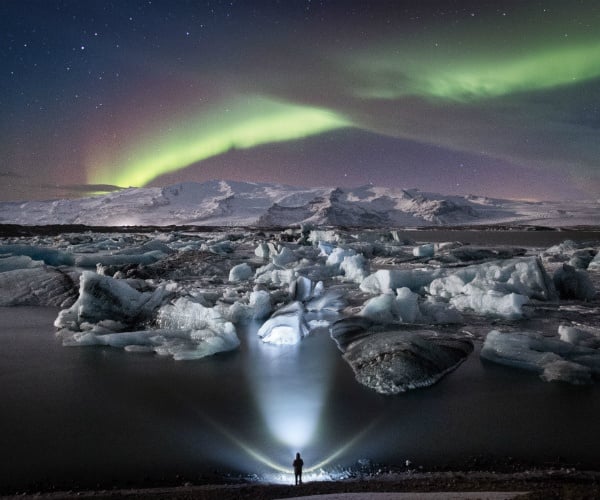 Icelandic climate
“It’s warmer than you think!”
Temperature
Iceland skirts the edges of the Arctic Circle between 64 and 66 degrees. You would be mistaken for thinking that means that Iceland is a barren icy tundra devoid of life, especially in winter. Thankfully this is not the case. In fact, other areas at the same latitude have a much colder climate in winter. While similar places in Canada might experience minus 20C and minus 30C throughout winter it’s rare for Icelanders to experience anything below minus 10C. And far more frequently, get to experience plus 5C or plus 10C. This is partially due to the Gulf stream constantly sending warm water from the gulf of Mexico up and around Iceland year round. Believe it or not, the average temperature in Iceland in January is actually above zero in many parts (0.3C to be exact). New York is colder, on average, than Iceland.
“If you don’t like the weather in Iceland… just wait five minutes.”
Temperate climate
It isn’t all good news though. With the warm air circulating Iceland and interacting with lower pressures a temperate climate is created. This can mean rain, snow, wind, sunshine and clouds. Maybe all on the same day. Many times throughout the winter I’ve had customers shiver as they walk towards the glacier for our hike. Then when on the ice, as the sun peeks out from the clouds they complain about overheating. This might have something to do with the seven layers they are wearing, but it also shows that the temperature can fluctuate quite drastically throughout the day.
Snow and ice
Snowfall and ice are a common sight in an Icelandic winter, but by no means guaranteed. There’s a reason Iceland isn’t known for its skiing. For every frozen snowstorm, there’s a heating event following it with rain to wash a lot of it away. For example, right now (mid December) it’s -8C with snow blanketing everything. Incredibly beautiful. But the forecast is suggesting the temperature is going to rise to +5C by the end of the week with rain accompanying it. If the warmer weather lasts long enough the snow may disappear before Christmas at this rate. Luckily, Iceland without snow is just as picturesque with the deep greens of the Icelandic moss covering many fields, punctuating the bright glacial blues that pour over the mountains in the distance.
Icelandic climate
“It’s warmer than you think!”
Temperature
Iceland skirts the edges of the Arctic Circle between 64 and 66 degrees. You would be mistaken for thinking that means that Iceland is a barren icy tundra devoid of life, especially in winter. Thankfully this is not the case. In fact, other areas at the same latitude have a much colder climate in winter. While similar places in Canada might experience minus 20C and minus 30C throughout winter it’s rare for Icelanders to experience anything below minus 10C. And far more frequently, get to experience plus 5C or plus 10C. This is partially due to the Gulf stream constantly sending warm water from the gulf of Mexico up and around Iceland year round. Believe it or not, the average temperature in Iceland in January is actually above zero in many parts (0.3C to be exact). New York is colder, on average, than Iceland.
“If you don’t like the weather in Iceland… just wait five minutes.”
Temperate climate
It isn’t all good news though. With the warm air circulating Iceland and interacting with lower pressures a temperate climate is created. This can mean rain, snow, wind, sunshine and clouds. Maybe all on the same day. Many times throughout the winter I’ve had customers shiver as they walk towards the glacier for our hike. Then when on the ice, as the sun peeks out from the clouds they complain about overheating. This might have something to do with the seven layers they are wearing, but it also shows that the temperature can fluctuate quite drastically throughout the day.
Snow and ice
Snowfall and ice are a common sight in an Icelandic winter, but by no means guaranteed. There’s a reason Iceland isn’t known for its skiing. For every frozen snowstorm, there’s a heating event following it with rain to wash a lot of it away. For example, right now (mid December) it’s -8C with snow blanketing everything. Incredibly beautiful. But the forecast is suggesting the temperature is going to rise to +5C by the end of the week with rain accompanying it. If the warmer weather lasts long enough the snow may disappear before Christmas at this rate. Luckily, Iceland without snow is just as picturesque with the deep greens of the Icelandic moss covering many fields, punctuating the bright glacial blues that pour over the mountains in the distance.
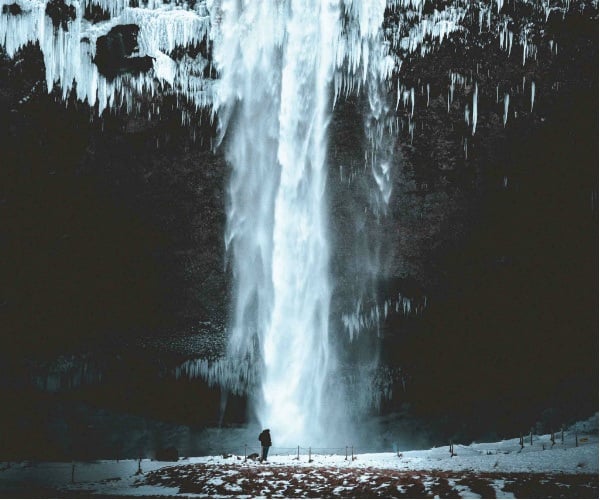 The wind
The wind is always the first thing that many people mention when talking about the weather in Iceland. When it’s windy, it’s memorable. The wind chill can make a +10C day feel like -5C. And without wind a -10C day can feel quite pleasant. Iceland is a windy place, sure, but I’m always quick to defend Iceland’s weather. It’s not as windy as often as you may think. Being from Scotland originally, I’m well equipped with the unpleasantness of a stiff wind so I feel like I can say this. The wind is like a pimple. You definitely notice when it’s there but pay little attention when it isn’t. Right now there is no wind. And as further proof I can confirm my adventure company very rarely cancels our glacier hikes due to the wind. Even on a windy day there’s often some respite in sheltered areas.
The darkness
The darkness that is associated with Icelandic winter is very real. No debate about that. As we approach the shortest day of the year we will barely get 4 hours of direct sunlight. This makes fitting in outdoor activities much harder so keep that in mind. It does however also mean you have ample time to hunt for the northern lights. As a general rule, from the 21st of December onwards you gain roughly 5 minutes of extra daylight per day. About half an hour a week. So if you come in October, early November and February or March the chances are you will have plenty of time to explore during the day.
The wind
The wind is always the first thing that many people mention when talking about the weather in Iceland. When it’s windy, it’s memorable. The wind chill can make a +10C day feel like -5C. And without wind a -10C day can feel quite pleasant. Iceland is a windy place, sure, but I’m always quick to defend Iceland’s weather. It’s not as windy as often as you may think. Being from Scotland originally, I’m well equipped with the unpleasantness of a stiff wind so I feel like I can say this. The wind is like a pimple. You definitely notice when it’s there but pay little attention when it isn’t. Right now there is no wind. And as further proof I can confirm my adventure company very rarely cancels our glacier hikes due to the wind. Even on a windy day there’s often some respite in sheltered areas.
The darkness
The darkness that is associated with Icelandic winter is very real. No debate about that. As we approach the shortest day of the year we will barely get 4 hours of direct sunlight. This makes fitting in outdoor activities much harder so keep that in mind. It does however also mean you have ample time to hunt for the northern lights. As a general rule, from the 21st of December onwards you gain roughly 5 minutes of extra daylight per day. About half an hour a week. So if you come in October, early November and February or March the chances are you will have plenty of time to explore during the day.
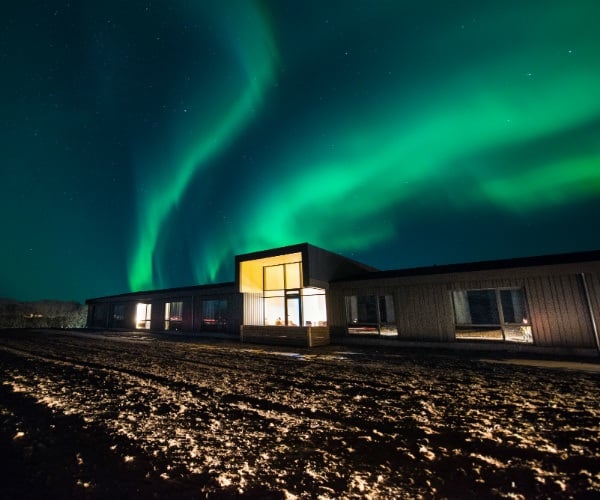 So with all that said, what should you do when you travel to Iceland to embrace this new climate and untamed wilderness?
The first ever Red storm in Iceland’s history: The Bomb Cyclone
Let me caveat the above title by stating that the colour gauge is a relatively new warning system for Iceland. This week’s storm was by no means the worst ever. But it certainly was the worst in the past few years. I can’t say I’ve experienced something quite like this since I started calling iceland my home.
It begun just a few days ago without much warning. I gasped to hear that in some parts of the country winds up to 50m/s (110mph) were being felt with 2 metres (7ft) of snow falling in quick succession. Houses were buried in snow and power outages were felt by over 20,000 people across the country. Videos of animals being rescued and people unable to get out of their houses was rife.
The people lucky enough to be stuck in Reykjavik were spared the worst of the winds but I can assure you, most businesses had closed up shop. Anyone who dared venture outside uploaded comical videos of them being blown off their feet. It seems making light of a difficult time is the way some people handle such moments.
For my part, I cancelled all our tours and urged all our guests to stay inside. This was the right thing to do in this circumstance but with virtually every road in the country preemptively closed down it was an inevitable one anyway.
So with all that said, what should you do when you travel to Iceland to embrace this new climate and untamed wilderness?
The first ever Red storm in Iceland’s history: The Bomb Cyclone
Let me caveat the above title by stating that the colour gauge is a relatively new warning system for Iceland. This week’s storm was by no means the worst ever. But it certainly was the worst in the past few years. I can’t say I’ve experienced something quite like this since I started calling iceland my home.
It begun just a few days ago without much warning. I gasped to hear that in some parts of the country winds up to 50m/s (110mph) were being felt with 2 metres (7ft) of snow falling in quick succession. Houses were buried in snow and power outages were felt by over 20,000 people across the country. Videos of animals being rescued and people unable to get out of their houses was rife.
The people lucky enough to be stuck in Reykjavik were spared the worst of the winds but I can assure you, most businesses had closed up shop. Anyone who dared venture outside uploaded comical videos of them being blown off their feet. It seems making light of a difficult time is the way some people handle such moments.
For my part, I cancelled all our tours and urged all our guests to stay inside. This was the right thing to do in this circumstance but with virtually every road in the country preemptively closed down it was an inevitable one anyway.
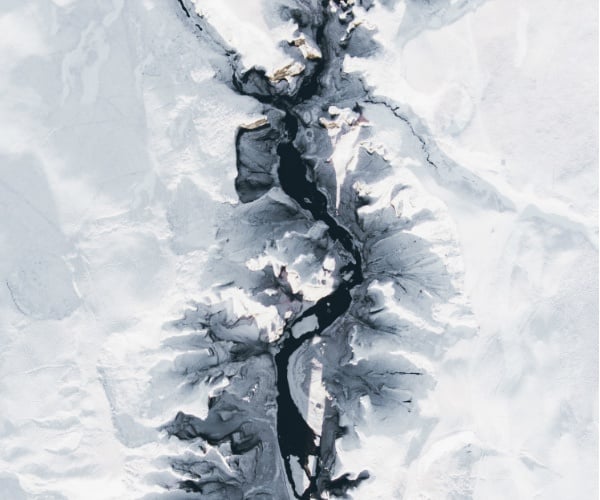 The great thing about Iceland though, is this is not exactly out of the ordinary. The early warning systems give everyone at least 1 day notice to prepare. The uncountable snow plows and brave Search & Rescue volunteers were at the ready to help the less fortunate and clear the roads. The other great thing about Iceland is that even the worst of the weather rarely lasts long. In fact, this ‘bomb cyclone’ hit the west coast around 3pm on Tuesday and had already dissipated a lot in Reykjavik by the same time the following day. By Thursday the sky was blue and people were slowly but surely getting back to normality in the city.
During these storms there’s still plenty to do indoors in Reykjavik. The Perlan Museum, Flyover Reykjavik and the Settlement Museum offer plenty of interactive educational fun. And the nightlife is well worth the time too.
Although these storms do happen in one shape or another every year it is by no means a weekly occurrence. This means tours and hotels remain functioning all year round. This allows you to enjoy the aspects of Iceland that are only possible in the winter months.
The golden hour – all day
Reading about this quite intense storm has probably given you some pause about choosing Iceland in the winter now. But I’m here to tell you that experiencing something like a bomb cyclone or weather so debilitating that you can’t do anything is very rare. Remember, there’s no such thing as an entire week of bad weather in Iceland. So let’s talk about the good weather.
Right now, just days after the storm. We have multiple guides out across the country hiking on bright blue glaciers, entering stable ice caves and hunting for the northern lights. Starry skies and sunny days. Snow is covering everything except the roads we need to get from A to B. Travel is easy and the sights are incredible.
The great thing about Iceland though, is this is not exactly out of the ordinary. The early warning systems give everyone at least 1 day notice to prepare. The uncountable snow plows and brave Search & Rescue volunteers were at the ready to help the less fortunate and clear the roads. The other great thing about Iceland is that even the worst of the weather rarely lasts long. In fact, this ‘bomb cyclone’ hit the west coast around 3pm on Tuesday and had already dissipated a lot in Reykjavik by the same time the following day. By Thursday the sky was blue and people were slowly but surely getting back to normality in the city.
During these storms there’s still plenty to do indoors in Reykjavik. The Perlan Museum, Flyover Reykjavik and the Settlement Museum offer plenty of interactive educational fun. And the nightlife is well worth the time too.
Although these storms do happen in one shape or another every year it is by no means a weekly occurrence. This means tours and hotels remain functioning all year round. This allows you to enjoy the aspects of Iceland that are only possible in the winter months.
The golden hour – all day
Reading about this quite intense storm has probably given you some pause about choosing Iceland in the winter now. But I’m here to tell you that experiencing something like a bomb cyclone or weather so debilitating that you can’t do anything is very rare. Remember, there’s no such thing as an entire week of bad weather in Iceland. So let’s talk about the good weather.
Right now, just days after the storm. We have multiple guides out across the country hiking on bright blue glaciers, entering stable ice caves and hunting for the northern lights. Starry skies and sunny days. Snow is covering everything except the roads we need to get from A to B. Travel is easy and the sights are incredible.
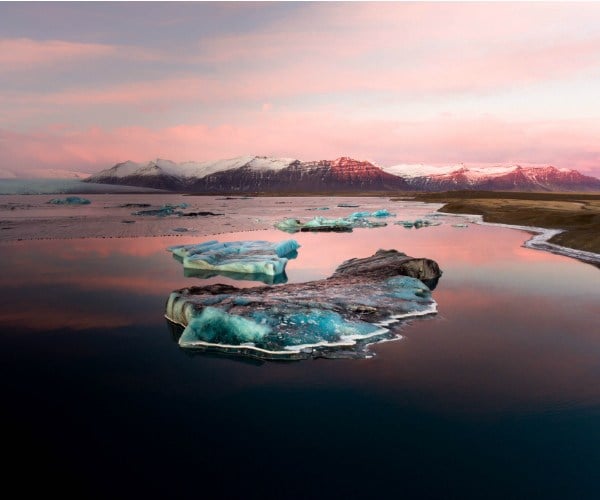 Most people think about the northern lights when they think about Icelandic winter. However, the fact that the sun barely rises above the horizon for the entire day means that every picture you take for a 5 hour period is in effect a ‘golden hour’ picture. Where else in the world will give you that Hollywood lit picture at midday. Perhaps there’s a reason Game of Thrones and James Bond were filmed in Icelandic winter. To be standing on the black diamond beach as the sun drops below the horizon is something to behold. The low sunlight penetrates the blocks of ice that have washed up on shore and makes them appear to glow.
Is winter worth it?
You can hike on the top of glaciers all year round. And the summer midnight sun keeps you warm enough to explore, even in the middle of the night. But winter, with its cold climate and dark nights transform the land and sky into something truly unique.
The ice cave season
By November the average temperature has dropped so much that the caverns, holes and cracks in the glacier have crept into the shape they will likely keep till spring. It’s the only time a temporary ice cave formed from summer melting can be accessed safely. Make sure that if you are interested in adventure from November to March add in an ice cave excursion. They genuinely are as blue as you see in the pictures.
Most people think about the northern lights when they think about Icelandic winter. However, the fact that the sun barely rises above the horizon for the entire day means that every picture you take for a 5 hour period is in effect a ‘golden hour’ picture. Where else in the world will give you that Hollywood lit picture at midday. Perhaps there’s a reason Game of Thrones and James Bond were filmed in Icelandic winter. To be standing on the black diamond beach as the sun drops below the horizon is something to behold. The low sunlight penetrates the blocks of ice that have washed up on shore and makes them appear to glow.
Is winter worth it?
You can hike on the top of glaciers all year round. And the summer midnight sun keeps you warm enough to explore, even in the middle of the night. But winter, with its cold climate and dark nights transform the land and sky into something truly unique.
The ice cave season
By November the average temperature has dropped so much that the caverns, holes and cracks in the glacier have crept into the shape they will likely keep till spring. It’s the only time a temporary ice cave formed from summer melting can be accessed safely. Make sure that if you are interested in adventure from November to March add in an ice cave excursion. They genuinely are as blue as you see in the pictures.
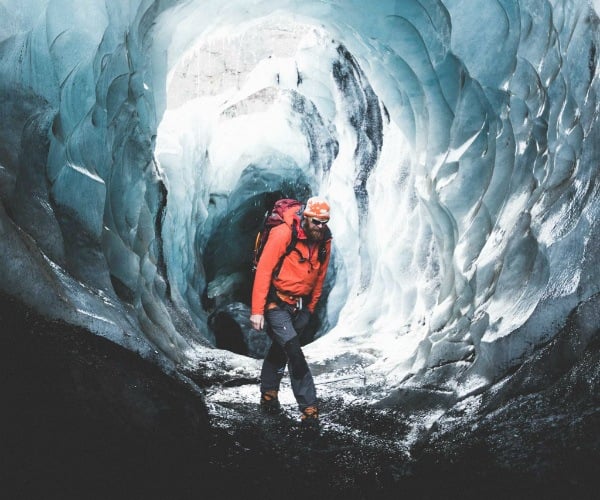 The Northern Lights
From early September to early April you can see the northern lights. But of course the longer night time gives you more time to play with and hope the clouds clear away at one point in the night. Seeing the northern lights is incredible but I always suggest doing other activities and finding secluded accommodation outside of the city so that if you’re not lucky enough to see them then at least you’ve had a good time doing other activities.
The Northern Lights
From early September to early April you can see the northern lights. But of course the longer night time gives you more time to play with and hope the clouds clear away at one point in the night. Seeing the northern lights is incredible but I always suggest doing other activities and finding secluded accommodation outside of the city so that if you’re not lucky enough to see them then at least you’ve had a good time doing other activities.
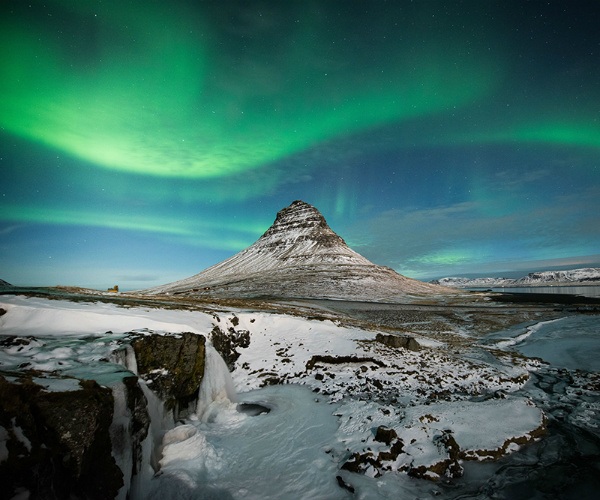 Snowfall and; blue glaciers
Despite my assertion that snow is not guaranteed in winter I would state that the higher altitude areas will be snow covered for the best part of winter. On the right week everything will be covered in snow. To see the blue glacier ice peaking out from a light dusting of fresh snow has an unrivalled beauty that can’t be matched by any other terrain in the world (in my opinion).
What to wear and how to experience Iceland safely
Snowfall and; blue glaciers
Despite my assertion that snow is not guaranteed in winter I would state that the higher altitude areas will be snow covered for the best part of winter. On the right week everything will be covered in snow. To see the blue glacier ice peaking out from a light dusting of fresh snow has an unrivalled beauty that can’t be matched by any other terrain in the world (in my opinion).
What to wear and how to experience Iceland safely
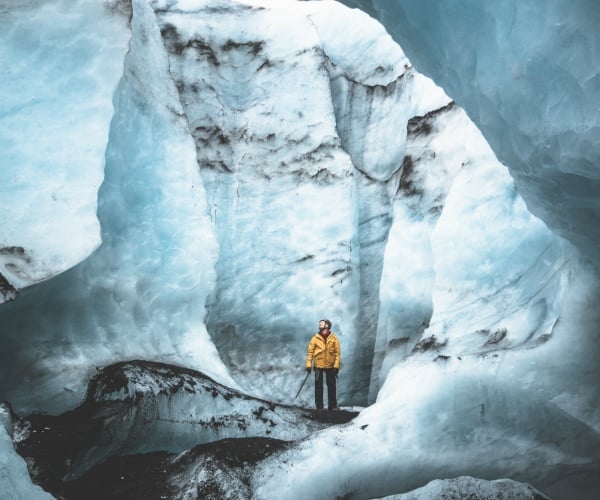 Packing for an Iceland adventure
So with all my comments about Iceland’s ever changing weather, packing is quite difficult. I can confirm from my own customers that many travellers try to stuff all their belongings into a carry on bag for their flight so it makes it even trickier.
Packing for an Iceland adventure
So with all my comments about Iceland’s ever changing weather, packing is quite difficult. I can confirm from my own customers that many travellers try to stuff all their belongings into a carry on bag for their flight so it makes it even trickier.
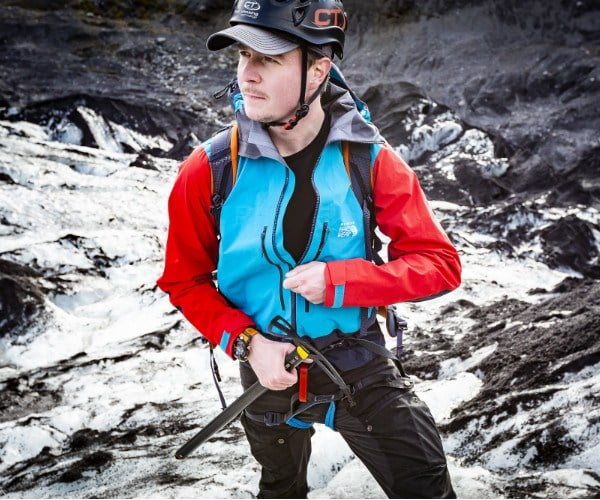 The first thing to throw out the window is the temperature gauge.
Or rather, don’t focus on the actual temperature.It never feels like it says. Just assume you’re going to be cold and go from there. I’ve worn as many layers in summer as I have in winter. What you’re really trying to achieve with your clothing choice is to tackle all weather types. And yes, I mean all weather types.
1. Warm base layers – this keeps your core temperature more stable (avoid cotton and denim), top and bottom.
2. Thick fleece or jumper – the chances are you will keep this on the majority of the time.
3. Warm waterproof jacket – the key is waterproof. Staying dry is essential for safety in Iceland.
4. Comfortable pants – combats or outdoor pants should suffice (avoid jeans).
5. Waterproof pants – you might think they look silly but being dry from top to toe is far more important.
6. Waterproof high ankle hiking boots – walking through slushy snow or getting rain splashing up the side of your legs is all it takes. Choose wisely.
7. Waterproof gloves and a warm hat that cover your ears – these are for happiness levels as much as warmth. There’s nothing worse than cold wind blasting off your ears.
8. Extra layers and spare everythings – as the temperature rises and falls you will find yourself taking things off and adding others. Extra socks when your feet get wet is pivotal.
9. Sunscreen… yes sunscreen. For every cold windy day there’s a sunny day too. On a reflective glacier sunblock is essential.
So you’re likely calculating how much luggage space you have based on the above. Luckily you’ll be wearing half the stuff most of the time anyway so that helps. But if you are doing any outdoor activities perhaps check with the tour company if you can hire some of the above. This can help with luggage space. You can be assured that what you borrow has been Iceland tested.
The first thing to throw out the window is the temperature gauge.
Or rather, don’t focus on the actual temperature.It never feels like it says. Just assume you’re going to be cold and go from there. I’ve worn as many layers in summer as I have in winter. What you’re really trying to achieve with your clothing choice is to tackle all weather types. And yes, I mean all weather types.
1. Warm base layers – this keeps your core temperature more stable (avoid cotton and denim), top and bottom.
2. Thick fleece or jumper – the chances are you will keep this on the majority of the time.
3. Warm waterproof jacket – the key is waterproof. Staying dry is essential for safety in Iceland.
4. Comfortable pants – combats or outdoor pants should suffice (avoid jeans).
5. Waterproof pants – you might think they look silly but being dry from top to toe is far more important.
6. Waterproof high ankle hiking boots – walking through slushy snow or getting rain splashing up the side of your legs is all it takes. Choose wisely.
7. Waterproof gloves and a warm hat that cover your ears – these are for happiness levels as much as warmth. There’s nothing worse than cold wind blasting off your ears.
8. Extra layers and spare everythings – as the temperature rises and falls you will find yourself taking things off and adding others. Extra socks when your feet get wet is pivotal.
9. Sunscreen… yes sunscreen. For every cold windy day there’s a sunny day too. On a reflective glacier sunblock is essential.
So you’re likely calculating how much luggage space you have based on the above. Luckily you’ll be wearing half the stuff most of the time anyway so that helps. But if you are doing any outdoor activities perhaps check with the tour company if you can hire some of the above. This can help with luggage space. You can be assured that what you borrow has been Iceland tested.
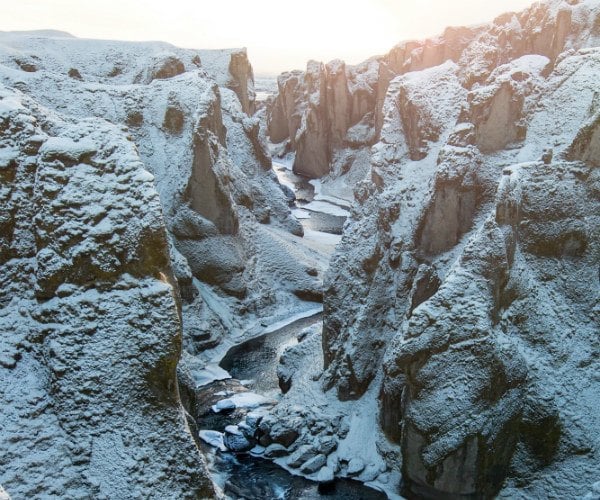 So now you know what you’re getting yourself into. It’s time for a few tips on how to do it all.
Hints and tips
1. Don’t drive unless you have extensive experience on ice, wind, snow and dark. Opt for small group or private tours. They’re more expensive but you’ll be glad of the expertise when the weather changes in a wilderness terrain.
2. Try to limit your time in Reykjavik. Spotting the northern lights from a secluded guest house in the middle of nowhere is far more pleasant than being driven around till 1am in a cramped bus.
3. Don’t trust the weather forecast too much. Bring your waterproof layer with you, even on a forecasted sunny day.
4. Do keep an eye on the weather though. Vedur (weather in Icelandic) is pretty good for general forecasts. Road.is tells you exactly what the roads are like up ahead in real time. If you are unsure if it’s safe to drive then don’t. Road.is also will alert you if the roads close unexpectedly.
5. Don’t expect the northern lights. Consider them a nice bonus on top of normal activities. Use Aurora Forecast for an accurate reading of the Northern Lights in real time.
6. Never ever ever step even one foot on a glacier on your own. It’s not illegal, but it is very very stupid. There are dozens of great guiding companies who would happily take you adventuring there safely. You’d be appalled at how many tourists try to walk on the glacier in trainers and fall.
So now you know what you’re getting yourself into. It’s time for a few tips on how to do it all.
Hints and tips
1. Don’t drive unless you have extensive experience on ice, wind, snow and dark. Opt for small group or private tours. They’re more expensive but you’ll be glad of the expertise when the weather changes in a wilderness terrain.
2. Try to limit your time in Reykjavik. Spotting the northern lights from a secluded guest house in the middle of nowhere is far more pleasant than being driven around till 1am in a cramped bus.
3. Don’t trust the weather forecast too much. Bring your waterproof layer with you, even on a forecasted sunny day.
4. Do keep an eye on the weather though. Vedur (weather in Icelandic) is pretty good for general forecasts. Road.is tells you exactly what the roads are like up ahead in real time. If you are unsure if it’s safe to drive then don’t. Road.is also will alert you if the roads close unexpectedly.
5. Don’t expect the northern lights. Consider them a nice bonus on top of normal activities. Use Aurora Forecast for an accurate reading of the Northern Lights in real time.
6. Never ever ever step even one foot on a glacier on your own. It’s not illegal, but it is very very stupid. There are dozens of great guiding companies who would happily take you adventuring there safely. You’d be appalled at how many tourists try to walk on the glacier in trainers and fall.
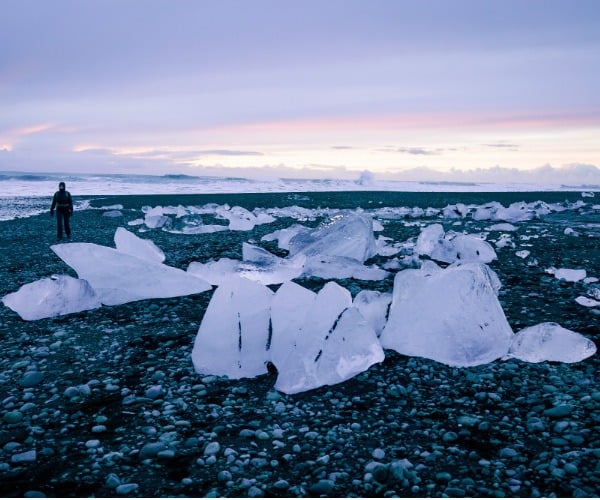 So these are just a few of the hints and tips to get you through an adventurous week in Iceland. You might encounter a storm but probably not the whole time. You’ll probably get some rain, snow and wind too. But if you can survive those days with a smile on your face the reward of dancing Aurora Borealis, glowing ice bergs and bright blue ice caves make it well worth it.
One final thing I tell my customers when the weather is hitting us just a little too hard as we venture behind a waterfall.
“Memories are made from experiences, not from pictures. If you can engage all 5 senses while doing something it can become something you remember forever. Iceland is certainly a place to overload them all.”
Thank you.
Ryan Connolly is Co-Founder of Hidden Iceland. Hidden Iceland specialises in private trips, taking you to some of the hidden gems of Iceland with a passionate and experienced guide.
If you would like to be a guest blogger on A Luxury Travel Blog in order to raise your profile, please contact us.
So these are just a few of the hints and tips to get you through an adventurous week in Iceland. You might encounter a storm but probably not the whole time. You’ll probably get some rain, snow and wind too. But if you can survive those days with a smile on your face the reward of dancing Aurora Borealis, glowing ice bergs and bright blue ice caves make it well worth it.
One final thing I tell my customers when the weather is hitting us just a little too hard as we venture behind a waterfall.
“Memories are made from experiences, not from pictures. If you can engage all 5 senses while doing something it can become something you remember forever. Iceland is certainly a place to overload them all.”
Thank you.
Ryan Connolly is Co-Founder of Hidden Iceland. Hidden Iceland specialises in private trips, taking you to some of the hidden gems of Iceland with a passionate and experienced guide.
If you would like to be a guest blogger on A Luxury Travel Blog in order to raise your profile, please contact us.Did you enjoy this article?
Receive similar content direct to your inbox.

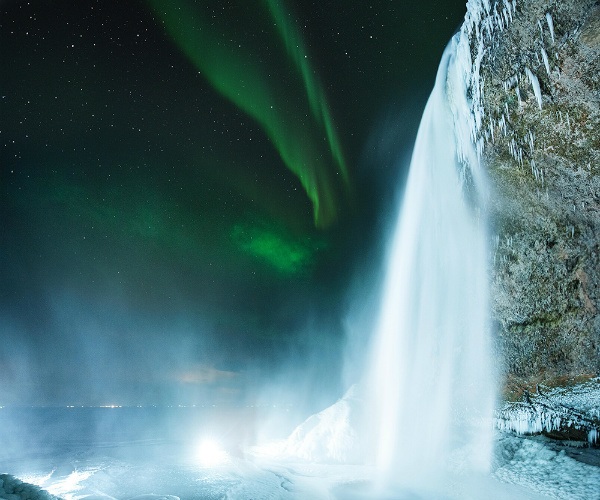

It was like being back at school. I began with good intentions to concentrate. Then I read the bit about the “Red storm”, my imagination went wild and I lost concentration. How wild does it get with a “Red storm”?
Understandable, a red storm does sound quite epic. They can get a bit hairy with the big dumps of snow and strong winds.
At least you get a day or 2 in advance to make provisions. Keeping indoors for a few days is key. Luckily Iceland is set up ready for these kinds of storms so the houses are built to withstand a lot.
The storms don’t get that extreme most of the time thankfully. Or they are very localised in certain regions which means there’s always a back up plan ready for action.
I’d say we experience maybe one or two very strong storms per winter and the rest is pretty manageable.
“If you don’t like the weather in Iceland… just wait five minutes.“
Those words sum up Iceland for me. You can get all 4 seasons within a day.
Agreed, no such thing as a bad week of weather in Iceland. Just a changeable one.
For me it’s the astounding picture of the Northern Lights that grabs my attention. Maybe it’s because there’s so much luck in whether you get a sighting or not. At the end of the day it will probably be the Northern Lights that lure me to Iceland.
It’s certainly a great lure. And then all the other attractions will complete the magical experience.
That’s really surprised me about the weather because I think I just assumed it would be freezing cold all the time. The fact that it’s probably warmer than Canada is a definite eye opener. Plus 5 or 10 degrees C, probably warmer than my house at the moment! The UK gets pretty mixed weather so I wouldn’t be too put off by the temperamental weather over there, sounds like it’s pretty changeable too which we British are used to though probably not to major extremes. I never really thought about the hours of sunlight in winter there either. That’s something to factor in if you’re hoping to explore during the day so you can make the most of the light while you have it.
The glaciers and Northern Lights, if you’re lucky enough to see them, would be top of my list if I ever manage an Iceland trip. It always strikes me as such a magical place, I’m not sure if that’s the way of life, the snow and ice, or the lights. Maybe a bit of everything.
Yeah, we’re currently experiencing the darkest days of the year right now and it comes with its challenges. But then more darkness means more potential northern lights. You never know.
The weather in Iceland is quite comparable to the UK, especially northern Scotland. Lots of great weather days but a few turbulent ones in between.
Loads of people I know rate Iceland as one of the top places that they’ve visited. The more adventurous ones seem to have enjoyed it the most. Reading this and looking at the stunning photos it seems to have so much diversity to the landscape and the things you can try.
Same here, Karen. I’ve only heard good things from the handful of people I’ve known to visit there. Two in particular are really into their winter holidays and they’re a bit more adventurous, but there are a few that I wouldn’t have pegged for Iceland lovers based on how they seem more inclined to sunshine and home comforts. One in particular, my mate’s girlfriend, went along with her boyfriend a couple of years ago a bit begrudgingly and came back raving about it. It does seem like you can’t not love the beauty of the place and there’s plenty to do whatever you’re interested in.
I would have thought the same for Iceland before coming here but I’ve personally found that the less adventurous still get a great trip. Especially when they join group tours or private tours. The infrastructure and safe aspects of Iceland make it family friendly.
That Bomb Cyclone recent sounds pretty intense. And it just came without much notice, it wasn’t expected? 110mph winds, and we find it tough in the UK when the speeds hit 40. 7ft of snow is epic for a short space of time but it’s worrying when this sort of extreme weather gets dangerous for people, vehicles, homes. Good shout on cancelling the tours. I imagine the severity differs when you get storms like this over there but the real extremes would be rare, and it’s good they’re usually short lived. I’d still like to go. At least the place and hotels and tour guides would be well versed in these weather events so it shouldn’t ruin a trip.
It was expected in the sense that we knew a storm was coming based on Atlantic forecasting. But you never know the extent of the storm until a day or two before. Luckily the weather reporting system in Iceland is so good that people have time to prepare.
Yeah, the storms in Iceland are often localised and less severe. We can usually plan around them. This one was done and dusted in 24 hours. Back to normality pretty quickly.
I hope you still come over to Iceland at some point and experience the good weather days.
Going to Iceland during winter is something I’ve never thought of. I’m not sure many do as well, except the more daring and adventurous ones. But this just reminded me that winter is the perfect time for the Northern Lights, but also opened my eyes that it might not be as icy cold and bleak as I thought it would be. You’d still have a bit of daytime to explore depending on the month, and bearable weather and that’s good enough for me!
Winter definitely comes with its challenges but if you are able to dodge the bad days the low light, snowy landscape and as you said Northern Lights are well worth it.